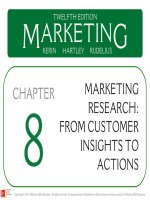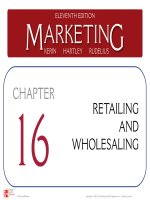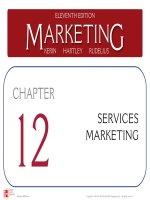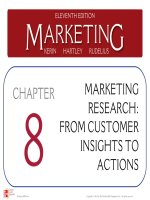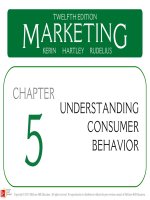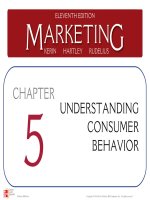Lecture Marketing (12/e): Chapter 17 – Kerin, Hartley, Rudelius
Bạn đang xem bản rút gọn của tài liệu. Xem và tải ngay bản đầy đủ của tài liệu tại đây (2.71 MB, 37 trang )
Copyright © 2015 McGrawHill Education. All rights reserved. No reproduction or distribution without the prior written consent of McGrawHill Education.
LEARNING OBJECTIVES (LO)
AFTER READING CHAPTER 17, YOU SHOULD BE ABLE TO:
LO 17-1
Discuss integrated marketing
communication and the
communication process.
LO 17-2
Describe the promotional mix and
the uniqueness of each component.
172
LEARNING OBJECTIVES (LO)
AFTER READING CHAPTER 17, YOU SHOULD BE ABLE TO:
LO 17-3
Select the promotional approach
appropriate to a product’s target
audience, life-cycle stage, and
characteristics, as well as stages
of the buying decision and channel
strategies.
LO 17-4
Describe the elements of the promotion
decision process.
LO 17-5
Explain the value of direct marketing for
consumers and sellers.
173
WHAT ARE THEY SAYING IN THE
TWITTERSPHERE? ¡YO QUIERO TACO BELL!
174
THE COMMUNICATION PROCESS
LO 17-1
Promotional Mix
•
Inform Prospective Buyers
•
Persuade Them To Try
•
Remind Them of the Benefits
Integrated Marketing
Communications (IMC)
175
FIGURE 17-1 The communication process
consists of six key elements
176
LO 17-1
THE COMMUNICATION PROCESS
Communication
Source
Message
Channel of
Communication
Receivers
177
THE COMMUNICATION PROCESS
LO 17-1
Field of Experience
Encoding
Feedback
Decoding
Response
Noise
Feedback Loop
178
MINI Paceman Ad
LO 17-1
Who is the source? What is the message?
How would you decode this ad?
179
FIGURE 17-2 The five elements of the
promotional mix
1710
THE PROMOTIONAL ELEMENTS
LO 17-2
ADVERTISING
Mass
Selling
Advertising
vs.
Customized
Interaction
•
Paid Aspect
•
Advantages
•
Nonpersonal
•
Disadvantages
1711
THE PROMOTIONAL ELEMENTS
LO 17-2
PERSONAL SELLING
Personal Selling
•
Wasted Coverage
•
Advantages
•
Disadvantages
1712
THE PROMOTIONAL ELEMENTS
LO 17-2
PUBLIC RELATIONS
Public Relations
•
Publicity
•
Advantages
•
Disadvantages
1713
LO 17-2
THE PROMOTIONAL ELEMENTS
SALES PROMOTION AND DIRECT MARKETING
Sales Promotion
•
Advantages
•
Disadvantages
•
Advantages
•
Disadvantages
Direct Marketing
1714
LO 17-3
IMC—DEVELOPING THE PROMOTIONAL MIX
THE TARGET AUDIENCE
Determine the Balance of the
Promotional Elements to be Used
Coordinate the Promotional Effort
Assess Target Audience
Characteristics
•
Consumers
•
Businesses
1715
MARKETING MATTERS
LO 17-3
How Can You Reach Today’s
College Students? With Mobile Marketing!
1716
FIGURE 17-3 The product life cycle illustrates
how promotional objectives and activities
change over the four stages
1717
LO 17-3
IMC—DEVELOPING THE PROMOTIONAL MIX
THE PRODUCT LIFE CYCLE
Introduction Stage
Growth Stage
Maturity
Stage
Decline Stage
1718
LO 17-3
IMC—DEVELOPING THE PROMOTIONAL MIX
PRODUCT CHARACTERISTICS
Complexity
Risk
Ancillary Services
1719
LO 17-3
IMC—DEVELOPING THE PROMOTIONAL MIX
STAGES OF THE BUYING DECISION
Prepurchase Stage
Purchase Stage
Postpurchase Stage
1720
FIGURE 17-4 The importance of promotional
elements varies during the stages of the
consumer purchase decision process
1721
LO 17-3
IMC—DEVELOPING THE PROMOTIONAL MIX
CHANNEL STRATEGIES
Push Strategy
Pull Strategy
•
Direct-to-Consumer
1722
FIGURE 17-5 A comparison of push and pull
promotional strategies
1723
FIGURE 17-6 The promotion decision process
includes planning, implementation, and
evaluation
1724
DEVELOPING AN IMC PROGRAM
LO 17-4
THE PROMOTION DECISION PROCESS
The Four “W”s:
•
Who is the Target Audience?
•
What are the Objectives, Budget, & Tools?
•
Where Should the Promotion Be Run?
•
When Should the Promotion Be Run?
1725


